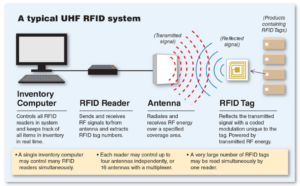Table of Contents
ПереключатьВведение
RFID, short for Radio-Frequency Identification, has quietly become an indispensable part of our world. From streamlining inventory management to expediting toll booth payments, this technology seamlessly reads data from small, unobtrusive tags. But how does this seemingly magical process actually work? This article delves deep into the intricacies of RFID-считыватели, revealing the ingenious engineering that allows them to identify and communicate with RFID-метки.

RFID Powering the Connection: The Art of Energy Harvesting and Backscatter Communication
At the heart of every RFID system lies the reader, acting as a conductor orchestrating the exchange of information. Unlike barcode scanners requiring a direct line of sight, RFID-считыватели utilize radio waves to communicate with tags. Now, imagine this: passive RFID tags, those tiny chips attached to products, don’t have their own power source. So how do they respond to the reader’s call?
The answer lies in a clever technique called “beam powering.” The RFID reader, through its antenna, emits electromagnetic waves that permeate the surrounding space. When a passive RFID tag enters this energized field, its internal antenna, usually a simple coil, captures a portion of this energy. This captured energy is then ingeniously utilized to power a tiny microchip within the tag, bringing it to life, albeit momentarily.
Once energized, the tag can finally respond to the reader. However, with such limited power harvested from the reader’s waves, it cannot simply blast back its own signal. This is where “backscatter” comes in. Think of it like a mirror reflecting light. The energized tag cleverly modulates – meaning it subtly alters – the reader’s incoming signal and reflects it back. This altered reflection, while still piggybacking on the reader’s energy, now carries the tag’s data encoded within its subtle variations.
Bridging the Gap: Inductive Coupling for Close-Range Harmony
While beam powering and backscatter are ideal for mid-range applications, short-range RFID communication often relies on a different principle – inductive coupling. Imagine two coils placed close to each other. When an alternating current flows through one coil, it creates a fluctuating magnetic field that, in turn, induces a current in the second coil.
Inductive coupling in RFID harnesses this elegant dance of electromagnetism. The reader’s antenna generates a focused magnetic field. When a tag comes within close proximity, typically a few centimeters, its internal antenna interacts with this fluctuating field. This interaction induces a current in the tag’s antenna, effectively transferring power wirelessly, much akin to how wireless charging pads energize our smartphones. This induced current then powers up the tag’s microchip, allowing it to send its identification data back to the reader, again utilizing modulated backscattering.
Reaching Further: Riding Electromagnetic Waves for Long-Distance Communication
For applications requiring extended ranges, such as tracking vehicles across a sprawling logistics yard or managing assets spread throughout a large warehouse, RFID systems leverage the power of long-range electromagnetic wave propagation. This is where we see the distinction between passive and active RFID tags.
Passive tags, as discussed earlier, rely solely on the reader’s electromagnetic field for both power and communication. While economical, their range is limited by the energy that can be harvested from the reader’s signal. Active tags, on the other hand, come equipped with their own internal batteries. This gives them the power to broadcast their own signals over much longer distances, often exceeding hundreds of meters.
Long-range RFID systems utilizing active tags generally operate at ultra-high frequencies (UHF), allowing their signals to travel further and penetrate obstacles more effectively. These systems are ideal for applications where tags might be moving at high speeds or are located a significant distance from the reader.
Deciphering the Whispers: From Reflected Signals to Actionable Information
The RFID reader doesn’t simply bask in the glow of reflected signals. It actively listens for specific patterns and modulations within the waves returning from the tags. The tag, using its minuscule power source, doesn’t shout back; it whispers in a pre-defined code. These codes, often adhering to industry standards like EPC (Electronic Product Code), are embedded within the subtle variations of the reflected signal.
Imagine the tag slightly delaying its reflection, or subtly changing the signal’s amplitude. These subtle shifts, imperceptible to human senses, are a language the reader understands. Sophisticated signal processing circuitry within the reader analyzes these variations, extracting the encoded data. This data, once deciphered, is then passed on to connected computer systems where it can be used for a multitude of purposes – be it updating inventory records, processing payments at a toll booth, or confirming the authenticity of a product.

Заключение
RFID readers, often overlooked in their ubiquity, are marvels of engineering. They seamlessly blend principles of electromagnetism, wireless power transfer, and digital communication to create a system capable of identifying and tracking objects without physical contact. Whether leveraging the elegance of inductive coupling for close-range interactions or harnessing the power of electromagnetic waves for long-distance communication, RFID readers are the unsung heroes of our increasingly interconnected world. By understanding their inner workings, we gain a deeper appreciation for the technology that silently powers so many aspects of our daily lives.
